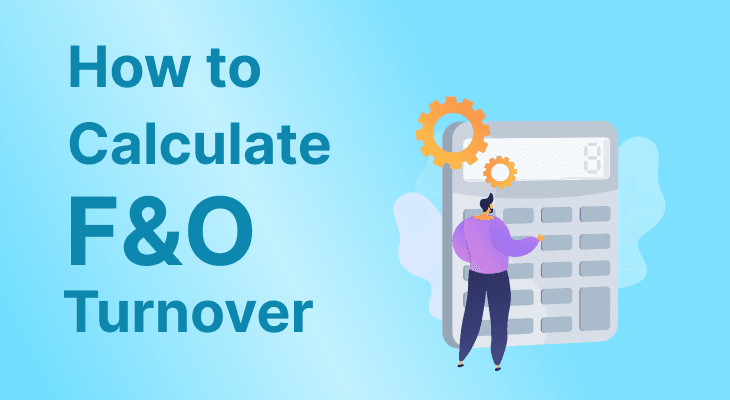
How to Calculate F&O Turnover?
The Futures and Options (F&O) market in India has grown in popularity among retail investors over the past few years. Understanding how to calculate F&O turnover helps to effectively assess your tax obligations.
F&O turnover is the sum of absolute values of profits and losses of your all future and options trades. For tax reasons, income from F&O trading is considered as business income.
Furthermore, understanding how to calculate turnover for F&O trading will help you evaluate whether you need to undergo a tax audit. Beyond a specific turnover threshold, you might need to undergo a tax audit. That is why F&O turnover calculation is important.
Futures And Options
Futures contracts are agreements to buy or sell an underlying asset or security at a fixed price on a future date. Options, on the other hand, provide the holder of the option the right but not the obligation to buy or sell an underlying asset or security at a defined price on or before a specific date.
These financial products are critical for risk management and price speculation in the financial markets. Whether you are an experienced trader or just starting out, understanding the fundamentals of futures and options is critical.
What is F&O Turnover?
F&O turnover is the total income from futures and options trading after accounting for all profits and losses. Trading in futures and options is taxed as business income. Thus, understanding how to appropriately calculate F&O turnover will help you plan your taxes better.
Importance of Calculating F&O Turnover
Accurate calculation of F&O turnover is important as it helps in:
- Determining Tax Liability: Your taxable income from derivatives trading is calculated based on F&O turnover.
- Assessing Eligibility for Tax Audit: If your turnover exceeds certain levels, a tax audit is required.
How To Calculate F&O Turnover?
To calculate F&O turnover, you must first understand how different types of transactions are treated and then aggregate them correctly. Here's a step-by-step guide:
- Aggregate Favourable and Unfavourable Differences: Add all positive and negative trade differences. This implies you must add up all profits and losses made in your trades over the financial year.
- Account for Reversed Trades: If a trade is reversed, the resultant difference must be included in the turnover.
- Calculate Futures Turnover: In futures trading, turnover is the absolute profit, which is the total of all gains and losses across transactions.
- Calculate Options Turnover: For options, add the absolute profit and losses on your trades and the premium earned for selling the options.
Formulae for Calculation
- Futures Turnover: Absolute Profit (the total of all profits and losses for the year).
- Options Turnover: Absolute Profit + Premium from selling options (if not already included).
F&O Turnover Example
Let us understand the calculation with an example:
Transactions:
- X Futures: Purchased 600 shares at ₹ 1,800 and sold at ₹ 1,950.
- Y Futures: Purchased 800 shares at ₹ 2,800 and sold at ₹ 2,750.
- Z Call Option: Bought 400 shares at ₹ 90 and sold at ₹ 120.
- W Put Option: Sold 600 shares at ₹ 55 and later purchased at ₹ 60.
Calculation:
Name | Transaction Type | Lot Size | Purchase Value | Sale Value | Gain/(Loss) | Turnover |
X | Future | 600 | ₹1080,000 | ₹ 11,70,000 | ₹ 90,000 | ₹ 90,000 |
Y | Future | 800 | ₹22,40,000 | ₹22,00,000 | ₹ (40,000) | ₹ 40,000 |
Z | Call Option | 400 | ₹ 36,000 | ₹ 48,000 | ₹ 12,000 | ₹ 12,000 |
W | Put Option | 600 | ₹ 36,000 | ₹ 33,000 | ₹ (3,000) | ₹ 3,000 |
Total | ₹ 59,000 | ₹ 1,45,000 |
Total Turnover = ₹ 90,000 (X) + ₹ 40,000 (Y) + ₹ 12,000 (Z) + ₹ 3,000 (W) = ₹ 1,45,000.
In this example, the total turnover for all transactions amounts to ₹ 1,45,000, while the net gain is ₹ 59,000.
F&O Losses and Tax Audit
Reporting your F&O turnover is mandatory, whether you make a profit or a loss. This is because F&O trading turnover is regarded as business income for taxation purposes. Calculating F&O turnover accurately is important since it affects your tax liability.
When is a Tax Audit required?
A tax audit under section 44AB is needed if:
- Your trading turnover exceeds ₹1 crore.
- Your trading turnover exceeds ₹2 crore, and you opt for the presumptive taxation scheme.
- You report losses and wish to carry them forward to future years.
Steps for a Tax Audit
If a tax audit is necessary, you will need to:
- Hire a Chartered Accountant: They will assist in creating financial statements such as the profit and loss account and balance sheet.
- File Tax Audit Report (Form 3CD): This form includes extensive information regarding transactions and turnover.
- Prepare and File ITR: To avoid penalties, the Income Tax Return must be filed accurately.
Conclusion
Learning how to calculate F&O turnover is vital for F&O traders. It impacts your tax obligations and regulatory compliance. By following the steps indicated above, you can make sure that your turnover is calculated accurately. Consult a Chartered Accountant, while managing the complexity of F&O trading and taxation.
FAQ
How do you show F&O turnover in ITR?
F&O turnover must be reported in your Income Tax Return (ITR) under the head Profits and Gains from Business or Profession. Depending on your income sources and the use of the presumptive taxation system, you must complete ITR-3 or ITR-4 with the necessary information. Ensure you record the turnover appropriately, including any profits and losses.
How is F&O turnover calculated for tax audits?
For tax audits, F&O turnover is calculated as the absolute total of all profits and losses from futures trades, as well as the absolute profit plus any premiums earned through options trading, provided that these premiums are not already included in the net profit. This total turnover number is then used to establish whether you fulfil the criteria for a tax audit.
What is the turnover limit for futures and option trading that requires a tax audit?
Options trading has a turnover limit of ₹1 crore, which triggers a tax audit. If you choose the presumptive taxation system, the ceiling climbs to ₹2 crore. If your turnover exceeds these limits, a tax audit is required.
Are F&O trading losses tax-deductible?
Yes, losses experienced through F&O trading can be carried forward and set off against your other business income. Your losses in F&O trading during a given financial year can be carried forward to be set off against your business income in subsequent financial years for up to 8 successive years.
Do I need to maintain detailed records of F&O transactions?
Yes, keeping accurate records of all F&O transactions is essential. This involves keeping account of trade dates, lot sizes, buying and selling prices, and any associated costs. These documents are required for proper turnover calculations and compliance with tax laws.
Can F&O trading be considered speculative?
No, F&O trading is regarded as non-speculative business income for income tax purposes. This categorisation allows losses from F&O trading to be set off against other business income, unlike speculative losses.
What expenses can be deducted from F&O turnover?
Expenses directly associated with F&O trading, such as brokerage fees, internet and phone charges, office rent, and other operational expenses can be deducted from turnover to arrive at your income. These deductions assist in determining the net taxable income from F&O trading.


